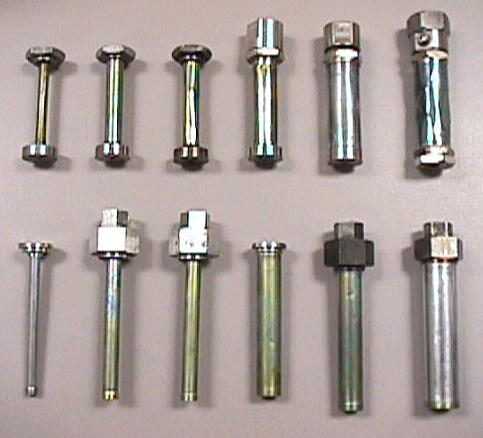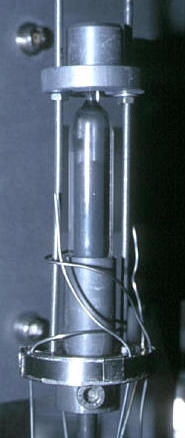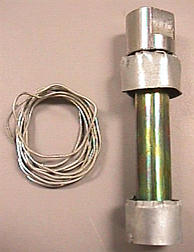 |
Samples & Sample Holders |
 |
Samples & Sample Holders |
Samples
Due to the fact that neutrons are produced as large relatively weak beams, the samples for powder neutron diffraction are large by comparison to those used for X-ray diffraction. They should still be ground as finely as possible so as to avoid spurious scattering from "single" crystals within the sample. As shown earlier, absorption is not a problem for most materials with a few notable exceptions: lithium, cadmium, and various rare-earth containing materials may be unsuitable for powder neutron diffraction experiments. If absorption is a problem, then one solution is to use a non-absorbing isotope, e.g. 7Li in lithium containing compounds. (Annecdotal evidence suggests that commercially-supplied lithium salts often only contain 7Li due to prior abstraction of the absorbing 6Li for military or other use.)
In addition, the large incoherent scattering cross-section of hydrogen is also a problem for powder neutron diffraction studies: the result is similar to that of the fluoresence effect in X-ray diffraction in that a poor signal to background is achieved (see example of HBr data). The solution is to substitute H by D in the preparation of samples for powder neutron diffraction. This may give the preparative scientist additional work (and expense) in the preparation of samples, especially for those working with organic materials.
Samples Holders
Neutron sample containers are nearly always cylindrical since absorption is not usually a problem for most samples. The choice of sample diameter, which is usually from 5 mm to 16 mm, depends largely on the amount of sample available. In few instances, a narrower sample might be chosen in preference to a wider one so as to avoid absorption, e.g. for compounds containing, say, chloride.
 |
 |
Some materials easily attack vanadium metal, e.g. acids and fluorides, so alternative sample holders are desirable. The most common alternative is quartz glass, as shown in the right-hand photograph above. Ordinary pyrex glass must not be used as it contains natural boron: one of the isotopes of boron, namely 10B, has a very high absorption cross-section for neutrons. Quartz glass is not attacked by acids or fluorides when absolutely dry. Thus it may used to hold materials such as rhenium heptafluoride, ReF7, which is highly corrosive. Another advantage of quartz is that is may be used from liquid helium temperatures to just below the melting point of quartz, though at high temperatures, crystallization of the glass may occur. Vanadium cans cannot be used to high temperatures, as even at very modest temperatures they may suffer sample attack.
Mounting the Sample
 Having filled the sample holder with powder, the next step is to mount it in
on the diffractometer.
For powder neutron diffraction, this is straight forward: the vanadium sample
can is simply screwed on to the diffractometer. If the sample is to be placed
in a cryostat or furnace, then it is simply screwed onto the end of a sample
stick that is inserted into the cryostat or furnace. Usually no alignment
of the sample is required other than height in the beam.
Quartz tubes are more difficult to mount: if they have a solid
quartz rod attached to one end, then it is possible to hold them in place using
three positioning screws; alternatively it sometimes possible
to mount them inside a vanadium sample can. In the above photograph, the
quartz tube was mounted by adjustable mounting pieces above and below it. The
bottom piece is made of boron nitride, BN. This is used
to prevent unwanted scattering from the bottom of the sample tube and it
provides an absorption shadow for sample height alignment.
More commonly, cadmium metal is used
to prevent scattering from the top and bottom pieces of vanadium sample
cans, as shown in the left-hand photograph.
Having filled the sample holder with powder, the next step is to mount it in
on the diffractometer.
For powder neutron diffraction, this is straight forward: the vanadium sample
can is simply screwed on to the diffractometer. If the sample is to be placed
in a cryostat or furnace, then it is simply screwed onto the end of a sample
stick that is inserted into the cryostat or furnace. Usually no alignment
of the sample is required other than height in the beam.
Quartz tubes are more difficult to mount: if they have a solid
quartz rod attached to one end, then it is possible to hold them in place using
three positioning screws; alternatively it sometimes possible
to mount them inside a vanadium sample can. In the above photograph, the
quartz tube was mounted by adjustable mounting pieces above and below it. The
bottom piece is made of boron nitride, BN. This is used
to prevent unwanted scattering from the bottom of the sample tube and it
provides an absorption shadow for sample height alignment.
More commonly, cadmium metal is used
to prevent scattering from the top and bottom pieces of vanadium sample
cans, as shown in the left-hand photograph.
For neutron scattering, where the volume of the sample is
very large in contrast to X-ray samples (by a factor of, say,
50×), then rotation of the sample is
not normally required unless the particle size is exceptionally large.
This can occur for samples that are condensed from the liquid or gas
phases: grinding a material such as the solid form of the
Freon gas CF2Cl2 at
77 K into a fine powder is no easy task and rotation or oscillation
may be necessary for this type of sample.
| © Copyright 1997-2006. Birkbeck College, University of London. | Author(s): Jeremy Karl Cockcroft |